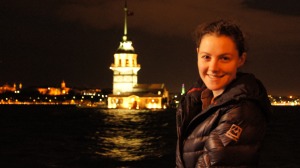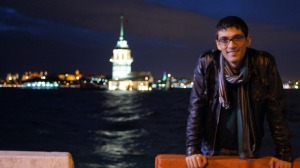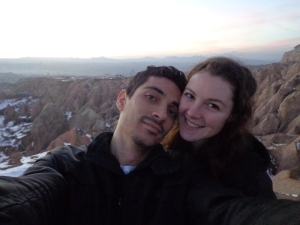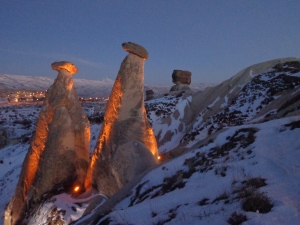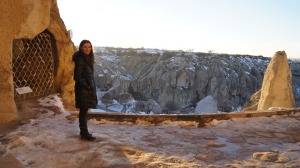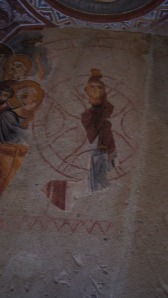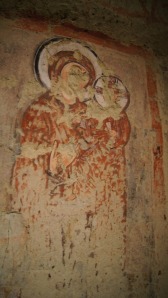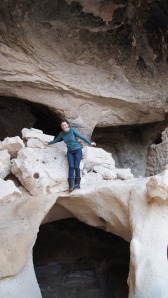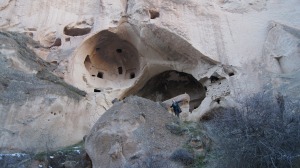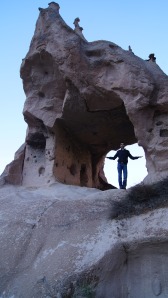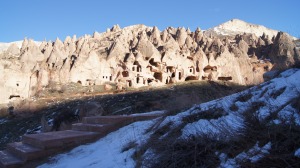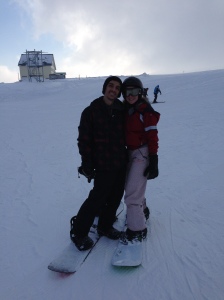
Ayasofya (or as us westerners know it, Hagia Sophia) was, again, one of my favorite places in Turkey. With beautiful architecture and history, it was hard not to fall in love with this beautiful church-turned-mosque.
My guide, (the awesome Süleyman) loved Ayasofya too and did a lot of research of his own because he was so intrigued by the history of it. He would tell the history and stories of the places we visited and many people would turn their heads to hear his stories. We even had a woman stand next to us for five minutes as he told the story about the angels with covered faces. I got a lot of information that a normal guide could give me.
 Walking into the outer entrance.
Walking into the outer entrance.
 At the inside entrance doors, it was already breathtakingly beautiful and huge.
At the inside entrance doors, it was already breathtakingly beautiful and huge.
 The inner entrance step. I love seeing old marble steps that have warped with so many feet.
The inner entrance step. I love seeing old marble steps that have warped with so many feet.
 The first thing you notice is the huge dome, with the beautiful windows circling the bottom. This huge dome (151 feet, 1 inch or 46 meters tall) the Statue of Liberty (without pedestal) could fit under the dome with 33 feet, or 10 meters to spare!
The first thing you notice is the huge dome, with the beautiful windows circling the bottom. This huge dome (151 feet, 1 inch or 46 meters tall) the Statue of Liberty (without pedestal) could fit under the dome with 33 feet, or 10 meters to spare!
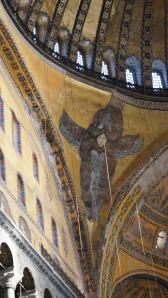 This angel was the only one without a covering on its face. In Islam (like I covered in Kapadokya) don’t allow faces to be seen of holy people because we can begin to idolize them. They covered up all of the faces of the angels on the four corners, but uncovered one to show what it did look like.
This angel was the only one without a covering on its face. In Islam (like I covered in Kapadokya) don’t allow faces to be seen of holy people because we can begin to idolize them. They covered up all of the faces of the angels on the four corners, but uncovered one to show what it did look like.
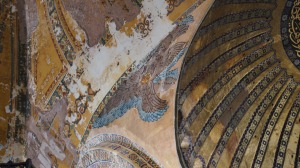 Three of the angels had large stars over their faces like this.
Three of the angels had large stars over their faces like this.
 The next thing you see are these large beautiful signs written in Arabic (like prayers). Süleyman said they were too big to fit through the inner or outer doors of the mosque, so they had to be built and painted inside. If you look really close you can see a person standing on the balcony near the sign. It was massive.
The next thing you see are these large beautiful signs written in Arabic (like prayers). Süleyman said they were too big to fit through the inner or outer doors of the mosque, so they had to be built and painted inside. If you look really close you can see a person standing on the balcony near the sign. It was massive.
 On the main floor was an area that was closed off. this area was where Byzantine Emperors have been coronated, called the “Omphalion.” And because of the natural light and columns, it was hard to get a decent picture of the area.
On the main floor was an area that was closed off. this area was where Byzantine Emperors have been coronated, called the “Omphalion.” And because of the natural light and columns, it was hard to get a decent picture of the area.
 This is the mihrab where the imam (prayer leader) would lead the service in prayer (complete with the bowing and kneeling). This marks the direction of Mecca, where Muslims pray toward. Mecca, located in Saudi Arabia. “Five times a day, Muslims face Mecca (holiest city of Islam, birthplace of Muhammad (their prophet), and site of the Kaaba, of House of God) to pray-at daybreak, noontime, midafternoon, sunset, and evening. These five obligatory prayers have to be performed in Arabic, regardless of the native tongue of the worshipper.” (Taken from “What Everyone Needs to Know about Islam: Second Edition” by John L. Esposito.” A few of the members of Sulu’s family prayed while I was there, but went into a different room. I did, however, witness a man praying at the airport before I came back to America. He had a small carpet that he laid on the ground and was very particular about the angle of the carpet, in respect to Mecca. When he was done praying, two other men came up and asked to borrow his carpet, and they shared the small carpet as they prayed separately.
This is the mihrab where the imam (prayer leader) would lead the service in prayer (complete with the bowing and kneeling). This marks the direction of Mecca, where Muslims pray toward. Mecca, located in Saudi Arabia. “Five times a day, Muslims face Mecca (holiest city of Islam, birthplace of Muhammad (their prophet), and site of the Kaaba, of House of God) to pray-at daybreak, noontime, midafternoon, sunset, and evening. These five obligatory prayers have to be performed in Arabic, regardless of the native tongue of the worshipper.” (Taken from “What Everyone Needs to Know about Islam: Second Edition” by John L. Esposito.” A few of the members of Sulu’s family prayed while I was there, but went into a different room. I did, however, witness a man praying at the airport before I came back to America. He had a small carpet that he laid on the ground and was very particular about the angle of the carpet, in respect to Mecca. When he was done praying, two other men came up and asked to borrow his carpet, and they shared the small carpet as they prayed separately.
 This is the mimbar, or minbar in some translations. It is the same as the mimbar in the Blue Mosque. Here is where the imam (or Muslim prayer leader) stands and gives a sermon (similar to a pulpit in a church). And just to the left of it is where the imam would lead the prayer, in the mihrab, above.
This is the mimbar, or minbar in some translations. It is the same as the mimbar in the Blue Mosque. Here is where the imam (or Muslim prayer leader) stands and gives a sermon (similar to a pulpit in a church). And just to the left of it is where the imam would lead the prayer, in the mihrab, above.
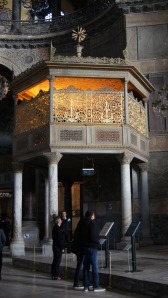 This is where the sultan, or high ruler, would pray, high above everyone else.
This is where the sultan, or high ruler, would pray, high above everyone else.
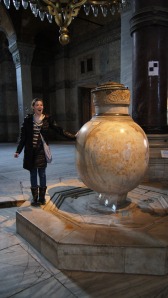 This was one of at least two large vases brought to the mosque from Pergamon in the late 1500s. It was carved from a single block of marble!
This was one of at least two large vases brought to the mosque from Pergamon in the late 1500s. It was carved from a single block of marble!
 An all-marble wall, made with at least five different types of marble.
An all-marble wall, made with at least five different types of marble.
 Light is very important in Mosques. Sulu was telling me about how there were dark mosaics all over the walls and ceilings, but they had to be changed to a lighter yellow color because it was extremely important for it to be light inside. That’s why so many mosques have windows all over the place. Ayasofya’s main floor was covered in chandeliers, powered with electricity, but before held candles. We thought the chandeliers (or at least most of them) were the original chandeliers.
Light is very important in Mosques. Sulu was telling me about how there were dark mosaics all over the walls and ceilings, but they had to be changed to a lighter yellow color because it was extremely important for it to be light inside. That’s why so many mosques have windows all over the place. Ayasofya’s main floor was covered in chandeliers, powered with electricity, but before held candles. We thought the chandeliers (or at least most of them) were the original chandeliers.
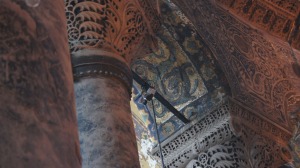 Here are some of the dark mosaics in the arches and beautiful carvings on the columns.
Here are some of the dark mosaics in the arches and beautiful carvings on the columns.
 Here is the famous wishing column. “The legend has it that, Emperor Justinian wandering in the building with a severe headache leaned his head to this column and after a while he realized that the headache was gone. This story had been heard among the public and the rumor regarding the healing effect of the column got around. Hence, people believed that they would get better if they put their fingers into that hole on the column and then rub them to the place where disease is felt, or that their wish would come true. […] [P]eople make their wishes by rotating their thumb a complete clockwise tour inside the hole (a much harder act than it looks!).” (Taken from http://www.ayasofyamuzesi.gov.tr/en/) As you walk around the first floor, this is your last stop before going upstairs.
Here is the famous wishing column. “The legend has it that, Emperor Justinian wandering in the building with a severe headache leaned his head to this column and after a while he realized that the headache was gone. This story had been heard among the public and the rumor regarding the healing effect of the column got around. Hence, people believed that they would get better if they put their fingers into that hole on the column and then rub them to the place where disease is felt, or that their wish would come true. […] [P]eople make their wishes by rotating their thumb a complete clockwise tour inside the hole (a much harder act than it looks!).” (Taken from http://www.ayasofyamuzesi.gov.tr/en/) As you walk around the first floor, this is your last stop before going upstairs.
 The horses’ walk up to the second floor… very steep, and a bumpy walk, so that anything could go to the second floor. I loved the lighting, it made me feel like I was there when it was used as a walkway.
The horses’ walk up to the second floor… very steep, and a bumpy walk, so that anything could go to the second floor. I loved the lighting, it made me feel like I was there when it was used as a walkway.
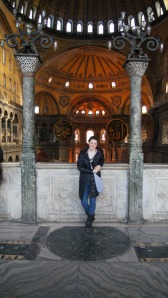 On the second floor is an area where the King would pray when Ayasofya was a church, above everyone else, facing the alter (which is directly behind me). This was marked by the different marble on the ground, as well as the best view of the mosque/church!
On the second floor is an area where the King would pray when Ayasofya was a church, above everyone else, facing the alter (which is directly behind me). This was marked by the different marble on the ground, as well as the best view of the mosque/church!
 The grave of Commandant Enrico Dandolo the Doge of Venice who commanded the 4th crusade and died in Istanbul in 1205 when he was 70 years old, is on the second floor of Ayasofya.
The grave of Commandant Enrico Dandolo the Doge of Venice who commanded the 4th crusade and died in Istanbul in 1205 when he was 70 years old, is on the second floor of Ayasofya.
 This is the biggest, and most likely the most famous, of the mosaics discovered in Ayasofya, “Deisis Composition.” It is the most damaged mosaic on display, and probably dates back to the 12th century. Many of the mosaics of Jesus and other holy people remained so intact was because the Muslim people who found them (they don’t allow faces in Islam) would try to destroy the faces. Many of these were quite tall, so instead they simply put something like a painting over them. What the original probably looked like is pictured below.
This is the biggest, and most likely the most famous, of the mosaics discovered in Ayasofya, “Deisis Composition.” It is the most damaged mosaic on display, and probably dates back to the 12th century. Many of the mosaics of Jesus and other holy people remained so intact was because the Muslim people who found them (they don’t allow faces in Islam) would try to destroy the faces. Many of these were quite tall, so instead they simply put something like a painting over them. What the original probably looked like is pictured below.
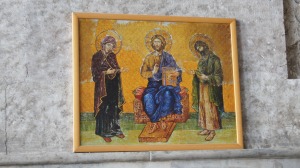 With Jesus in the middle, John the Baptist on his left, and the Virgin Mary on his right. This mosaic is located on the second floor.
With Jesus in the middle, John the Baptist on his left, and the Virgin Mary on his right. This mosaic is located on the second floor.
 Zoe Mosaic, dating back to the 11th century, located on the second floor. Jesus is located in the middle, with Emperor IX. Konstantinos Monomakhos on his right, and Empress Zoe on his left.
Zoe Mosaic, dating back to the 11th century, located on the second floor. Jesus is located in the middle, with Emperor IX. Konstantinos Monomakhos on his right, and Empress Zoe on his left.
 Komnenos Mosaic. Dating back to the 12th century, Virgin Mary is in the center with baby Jesus in her arms, Emperor II. Ioannes Komnenos, sits to Mary’s right and his wife Eirene and their son II. Aleksios sit to Mary’s left. Aleksios is hard to see, just to the left of Eirene, the mosaic curves from a wall, and he is on the next panel (on the far right of the picture). He is portrayed as pale and skinny because he died of an illness when he was young. Komnenos Mosaic is located on the far wall on the second floor, next to the Zoe Mosaic and the leaning column (below).
Komnenos Mosaic. Dating back to the 12th century, Virgin Mary is in the center with baby Jesus in her arms, Emperor II. Ioannes Komnenos, sits to Mary’s right and his wife Eirene and their son II. Aleksios sit to Mary’s left. Aleksios is hard to see, just to the left of Eirene, the mosaic curves from a wall, and he is on the next panel (on the far right of the picture). He is portrayed as pale and skinny because he died of an illness when he was young. Komnenos Mosaic is located on the far wall on the second floor, next to the Zoe Mosaic and the leaning column (below).
 On the second floor, near the last two mosaics (below), was this leaning column. There are no explanations about it, nothing shouting that it was there. Sulu noticed it (because he’s a designer, and he always notices small things like that), and decided to do some research on it. He found out that is the column that the newest tower rests on. They first started building the tower with the same stone (so it would look symmetrical), but soon learned it was too heavy because it was breaking the architecture of the mosque, so they had to quickly change to a much lighter rock (brick). They leaning column still stayed that way though.
On the second floor, near the last two mosaics (below), was this leaning column. There are no explanations about it, nothing shouting that it was there. Sulu noticed it (because he’s a designer, and he always notices small things like that), and decided to do some research on it. He found out that is the column that the newest tower rests on. They first started building the tower with the same stone (so it would look symmetrical), but soon learned it was too heavy because it was breaking the architecture of the mosque, so they had to quickly change to a much lighter rock (brick). They leaning column still stayed that way though.
 Here is a bottom view out a window near the leaning column.
Here is a bottom view out a window near the leaning column.
 Here is a better view of the newest tower. Compare the darker brick to the lighter brick of the picture below.
Here is a better view of the newest tower. Compare the darker brick to the lighter brick of the picture below.
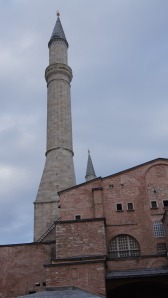 This was one of the original towers, with the lighter, and heavier rock.
This was one of the original towers, with the lighter, and heavier rock.
 The hallway on the second floor. You can see the “Deisis Composition” in the middle of the picture, on the left side of the hall. Also, if you notice the small black and white checkers on the left and right of the picture above, Sulu asked a security guard about them (they were EVERYWHERE!) We thought they might have put them there to do a 3D model, but really they were marking for restoration. We came at a good time because soon they were going to shut down Ayasofya to do an entire restoration! Good timing!
The hallway on the second floor. You can see the “Deisis Composition” in the middle of the picture, on the left side of the hall. Also, if you notice the small black and white checkers on the left and right of the picture above, Sulu asked a security guard about them (they were EVERYWHERE!) We thought they might have put them there to do a 3D model, but really they were marking for restoration. We came at a good time because soon they were going to shut down Ayasofya to do an entire restoration! Good timing!
 Sulu checking out the view from the second floor.
Sulu checking out the view from the second floor.
 The view just outside one of the windows, of the Blue Mosque.
The view just outside one of the windows, of the Blue Mosque.
 As you exited the building, right above the famous, huge brass doors (below) there was a mirror showing another mosaic, so you wouldn’t miss it!
As you exited the building, right above the famous, huge brass doors (below) there was a mirror showing another mosaic, so you wouldn’t miss it!
 Sunu Mosaic (picture from http://www.ayasofyamuzesi.gov.tr/en/). It was discovered during the repair process in 1849. In the center is the Virgin Mary holding baby Jesus. On her left is Emperor Konstantinos I. holding a model representative of Constantinople, what is now Istanbul. To the right of Mary is Emperor Justinianos presenting them with a model of Hagia Sophia. This mosaic is dated back to the 10th century.
Sunu Mosaic (picture from http://www.ayasofyamuzesi.gov.tr/en/). It was discovered during the repair process in 1849. In the center is the Virgin Mary holding baby Jesus. On her left is Emperor Konstantinos I. holding a model representative of Constantinople, what is now Istanbul. To the right of Mary is Emperor Justinianos presenting them with a model of Hagia Sophia. This mosaic is dated back to the 10th century.
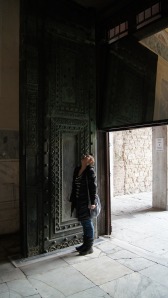 The famous doors of Ayasofya. 7 meters tall (almost 23 feet), and made of oak with a bronze frame, these are the largest doors in Ayasofya. According to (http://www.ayasofyamuzesi.gov.tr/en/), “East-Roman references says the door could be made of the woods of Noah’s ark or the wood of the chest of which the Jewish holy plates kept in.”
The famous doors of Ayasofya. 7 meters tall (almost 23 feet), and made of oak with a bronze frame, these are the largest doors in Ayasofya. According to (http://www.ayasofyamuzesi.gov.tr/en/), “East-Roman references says the door could be made of the woods of Noah’s ark or the wood of the chest of which the Jewish holy plates kept in.”
 This was one of the only “hamams” I saw, also called Turkish bath. I was a little too afraid to try this (but maybe on my next trip!). Apparently, they are separated into men’s and women’s, and it starts with a sauna-type room, called the “warm room,” then onto a hotter sauna, called the “hot room,” then after a full-body wash and massage, finish with a “cooling room.” We saw this near the cafe after exiting Ayasofya, we thought it had turned into a restaurant because there were many tables right outside the entrance.
This was one of the only “hamams” I saw, also called Turkish bath. I was a little too afraid to try this (but maybe on my next trip!). Apparently, they are separated into men’s and women’s, and it starts with a sauna-type room, called the “warm room,” then onto a hotter sauna, called the “hot room,” then after a full-body wash and massage, finish with a “cooling room.” We saw this near the cafe after exiting Ayasofya, we thought it had turned into a restaurant because there were many tables right outside the entrance.
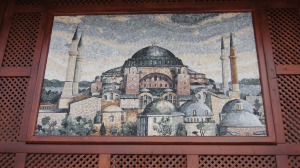 This beautiful mosaic of Ayasofya was at a cafe near it.
This beautiful mosaic of Ayasofya was at a cafe near it.
 Walking to the Blue Mosque (a 5-10 minute walk), turn around and see this heavenly looking Ayasofya. From this view you can see the different colored towers (the closer tower on the right side is the newest with the lighter rock, it is also somewhat thinner in diameter).
Walking to the Blue Mosque (a 5-10 minute walk), turn around and see this heavenly looking Ayasofya. From this view you can see the different colored towers (the closer tower on the right side is the newest with the lighter rock, it is also somewhat thinner in diameter).
Much of my information was from (http://www.ayasofyamuzesi.gov.tr/en/).
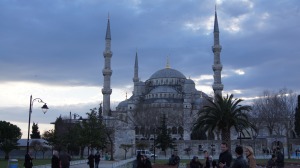 The Blue Mosque, also called the Sultan Ahmed Mosque (in Turkish, Sultanahmet Camii). It was built in the early 1600s
The Blue Mosque, also called the Sultan Ahmed Mosque (in Turkish, Sultanahmet Camii). It was built in the early 1600s This bronze sculpture was in the courtyard of the Blue Mosque. You can see how the six towers are arranged, an easy spot when looking across a river!
This bronze sculpture was in the courtyard of the Blue Mosque. You can see how the six towers are arranged, an easy spot when looking across a river!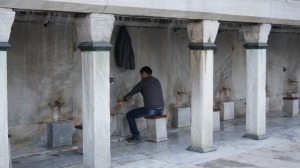 Here is a man doing the ritual washing. He has to wash his hands, feet and face before allowing himself to pray. This was outside in the courtyard. Some mosques have a column in the middle of the courtyard with 10 or 15 washing stations, this mosque had many along the walls.
Here is a man doing the ritual washing. He has to wash his hands, feet and face before allowing himself to pray. This was outside in the courtyard. Some mosques have a column in the middle of the courtyard with 10 or 15 washing stations, this mosque had many along the walls. Here we are on the short (5-10) minute walk from Ayasofya to the Blue Mosque.
Here we are on the short (5-10) minute walk from Ayasofya to the Blue Mosque. Here is a picture of the Blue Mosque from Ayasofya. You can almost see all 6 towers.
Here is a picture of the Blue Mosque from Ayasofya. You can almost see all 6 towers. The beautiful dome of the mosque; this picture does not do it justice, the details you can see with the naked eye are remarkable. The entire dome is a mosaic, which just makes it so much more beautiful. The wires hanging from the ceiling are holding the massive chandelier.
The beautiful dome of the mosque; this picture does not do it justice, the details you can see with the naked eye are remarkable. The entire dome is a mosaic, which just makes it so much more beautiful. The wires hanging from the ceiling are holding the massive chandelier. On the original chandeliers, there were ostrich eggs to repel spiders, but most have been taken away now, and use electronic light, not candles.
On the original chandeliers, there were ostrich eggs to repel spiders, but most have been taken away now, and use electronic light, not candles.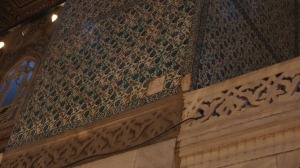 Part of the mosaic/tile of the wall, obviously in need of a little repair.
Part of the mosaic/tile of the wall, obviously in need of a little repair. Here Süleyman is showing me how to pray.
Here Süleyman is showing me how to pray. In the prayer-only area, there is a weird-looking structure like this (in most Mosques), called a Mimbar; you can compare it to a pulpit in a church. Here is where the imam (or Muslim prayer leader) stands and gives a sermon. And just to the left of it is where the imam would lead the prayer, in the mihrab.
In the prayer-only area, there is a weird-looking structure like this (in most Mosques), called a Mimbar; you can compare it to a pulpit in a church. Here is where the imam (or Muslim prayer leader) stands and gives a sermon. And just to the left of it is where the imam would lead the prayer, in the mihrab. This is one of the widest columns in a mosque in the world. It’s so wide that it takes three blocks of marble on top of each other to create the entire column.
This is one of the widest columns in a mosque in the world. It’s so wide that it takes three blocks of marble on top of each other to create the entire column. This mosque was one where people actually prayed normally, there was only a small section of the mosque where pictures were allowed to be taken, the rest was for prayer. We had to take our shoes off, even though we weren’t going to pray, and they even offered scarves to cover women’s hair.
This mosque was one where people actually prayed normally, there was only a small section of the mosque where pictures were allowed to be taken, the rest was for prayer. We had to take our shoes off, even though we weren’t going to pray, and they even offered scarves to cover women’s hair.


